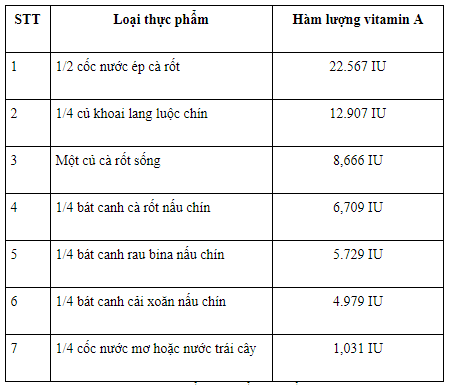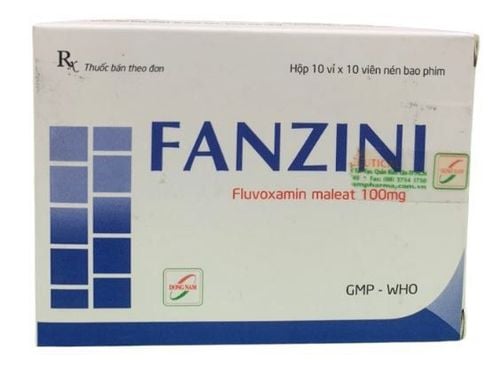This is an automatically translated article.
The article was professionally consulted with Specialist Doctor I Dang Thi Ngoc Chuong - Pediatrician - Pediatrics - Neonatal Department, Vinmec Central Park International General Hospital.Worldwide, children with clinical vitamin A deficiency are more likely to have infectious diseases and are at risk for vision problems including blindness. Therefore, supplementing foods rich in vitamin A for children is very necessary.
1. Why is vitamin A important?
The term "vitamin A" refers to a group of organic compounds that includes:Provitamin A: Compounds such as retinol, retinal, retinoic acid, and retinol palmitate are derived from animal products and are taken by the body It is easy for people to assimilate, absorb and use. Provitamin carotenoids: A plant-based pigment that cells can convert to provitamin A. One of the best known provitamin carotenoids is beta carotene, which helps carrots, sweet potatoes, apricots, and other fruits other plants and vegetables are bright orange. Vitamin A plays an important role in vision development as well as bone growth and helps protect children against infections. Vitamin A also promotes the growth of cells and tissues in the body, especially hair, nails and skin. In addition, vitamin A also has the ability to strengthen the immune system, helping the baby's body to have enough resistance to fight off diseases.

During pregnancy, the baby needs vitamin A to ensure the normal development of the organs. Vitamin A is necessary for gene transcription and the normal functioning of the immune system in the child's body. Vitamin A is important for eye development as well as normal vision function including the ability to see clearly in low light conditions. Vitamin A deficiency can worsen symptoms of autism in children with autism spectrum disorders. Worldwide, children with clinical vitamin A deficiency are more likely to have infectious diseases and are at risk for vision problems including blindness. Vitamin A deficiency is relatively rare in developed countries, but in developing countries it is a different matter. For these countries, vitamin A deficiency has been and continues to be a major cause of blindness and even death in children.
2. The best source of vitamin A

Vitamin A of animal origin: The richest source of vitamin A in animal foods is the liver. However, the liver actually contains too much vitamin A for what is needed, especially for children. Therefore, experts recommend that parents should not give their children too much animal liver, instead, direct their children's attention to other foods with moderate vitamin A content such as foods with moderate vitamin A content. Oily fish such as salmon is typical or milk and dairy products such as butter, cheese, yogurt .... Vitamin A of vegetable origin: Plant sources of vitamin A include vegetables such as: carrot, pumpkin, sweet potato, apricot, mango, papaya and cantaloupe. Beta carotene is also found in dark green leafy vegetables, like spinach and kale. Vitamin A Supplements: The top popular vitamin A supplements include retinyl palmitate - vitamin A. There are also several other medications that add vitamin A in the form of beta carotene. Besides, some foods fortified with vitamin A can also be considered as reasonable sources such as milk, cooking oils and cereals. Here is a list of some foods, sorted by their vitamin A content, in IU:

3. Can a child get too much vitamin A?
The answer will be yes. Normally, the body needs to convert vitamin A from an inactive form to an active form before it can be used for other purposes. In most cases, vitamin A excess is caused by taking supplements that contain high levels of active vitamin A. Children can also get vitamin A in its excessively active form through a diet rich in foods of animal origin such as liver and milk. For example, beef liver can contain up to 21,566 IU per slice.In contrast, an excess of vitamin A is almost impossible in the case of mothers who feed their babies a lot of foods containing beta carotene or carotenoids such as carrots, citrus fruits,... Given the vitamins from these sources, the body converts only what it needs from the carotenoids into the active form of vitamin A. This leads to one of the characteristics of babies who eat too many carrots is that the skin will gradually turn to Orange. This phenomenon will stop when the child returns to a normal diet.
Children with too much vitamin A can experience weakness, headaches, nausea, dry skin and many other symptoms. Over time, a chronic excess of preformed vitamin A can cause osteoarthritis pain and bone calcification leading to osteoporosis. So vitamin A supplements as directed by doctors can be a helpful approach for children with vitamin A deficiency. But if not, supplements can have the opposite effect by a healthy child. Strong and well-nourished will easily absorb too much vitamin A.

4. How much vitamin A is too much?
Children 1 to 3 years old should get no more than 2,000 IU of vitamin A per day. Meanwhile, children 4 to 8 years old should get no more than 3,000 IU of vitamin A per day. These are the maximum levels considered safe by the Food and Nutrition Board of the Institute of Medicine. In addition, they also recommend that parents do not give their children vitamin A supplements containing more than the recommended amount of vitamin A that children need each day.Too much active vitamin A can cause nausea and vomiting, headaches, dizziness, blurred vision, and lack of muscle coordination. Long-term effects can lead to premature osteoporosis, liver problems, and central nervous system disorders.
Below is the recommended daily allowance for vitamin A published by the US National Institutes of Health. This list reflects the average amount of vitamin A a child should get each day. The unit of measurement used is RAE (equivalent to retinol activity) measured in micrometers per day. The list also provides the international unit (IU) equivalent values found on some other vitamin A food and supplement labels.
Recommended daily allowance by age:

For children 1-3 years old: 300 RAE micrograms/day (equivalent to 1,000 IU). For children 4-8 years old: 400 RAE micrograms/day (equivalent to 1,330 IU). For children 9-13 years old: 600 RAE micrograms/day (equivalent to 2,000 IU). Considering whether the above intake is tolerable or not, the recommended amount of vitamin A for children should not exceed the maximum recommended amount per day according to age, specifically:
For children 1-3 years old: 600 RAE microgram/day (equivalent to 2,000 IU). For children 4-8 years old: 900 RAE micrograms/day (equivalent to 3,000 IU). For children 9-13 years old: 1700 RAE micrograms/day (equivalent to 5660IU). It should be noted that the maximum recommended daily intake of vitamin A for children by age does not refer to carotenoid intake. If children can meet their vitamin A needs with foods rich in carotenoids, parents need not worry too much about limiting their baby's intake.
Vitamin A is a very important nutrient for the health and development of infants and young children. Vitamin A deficiency will lead to a number of problems related to the baby's vision, intelligence as well as physical development. However, too much vitamin A can also bring many consequences for the baby. Therefore, parents need to know how much vitamin A their child needs each day, what is the best source of vitamin A and how to supplement vitamin A to avoid excess or deficiency of vitamin A.
Besides vitamin A, parents also need to supplement their children with essential micro-minerals such as zinc, lysine, chromium, selenium, vitamin B1, ... to fully meet the needs of nutrients in children. The addition of these essential vitamins also supports digestion, enhances nutrient absorption, improves anorexia, and helps children eat well. Parents can simultaneously apply dietary supplements and functional foods derived from nature for easy absorption. Do not forget to regularly visit the website vimec.com to update useful baby care information.
Please dial HOTLINE for more information or register for an appointment HERE. Download MyVinmec app to make appointments faster and to manage your bookings easily.
References: babycenter.com, parentingscience.com, bellamysorganic.com.au
Recommended video:
Role of vitamin A in children's health














